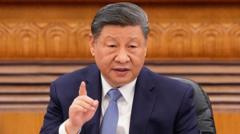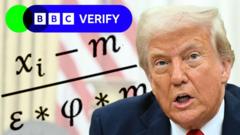As President Trump rolls out tariffs affecting nearly all major trading partners, China voices strong opposition, citing potential retaliatory measures and emphasizing the economic implications for Southeast Asia.**
Trump's Tariff Strategy Shifts Focus to Asia: Implications for China and Southeast Asia**

Trump's Tariff Strategy Shifts Focus to Asia: Implications for China and Southeast Asia**
The new wave of tariffs announced by President Trump generates tension in U.S.-China relations while impacting neighboring Southeast Asian economies.**
President Donald Trump has recently introduced a comprehensive range of tariffs targeting nearly all of America's trading partners, bringing renewed focus on China's trade practices. During a detailed address, Trump emphasized his respect for Chinese President Xi Jinping but accused China of taking significant advantage of the United States, referring to a substantial 67% tariff on U.S. goods by China.
Trump announced a new "discounted reciprocal tariff" structure, declaring that the U.S. would impose a 34% tariff on Chinese imports in response to these trade barriers. In light of this announcement, China's Commerce Ministry condemned the tariffs as an act of "unilateral bullying," pledging to enact "resolute countermeasures" to protect its economic interests. The Chinese media also criticized Trump’s strategy as a simplistic tit-for-tat approach.
The tariffs add to the already-existing 20% levies imposed on Chinese products, with expectations that these will escalate substantially to 54% shortly. Furthermore, Trump's latest tariffs profoundly affect Southeast Asian countries such as Vietnam, Laos, and Cambodia, which might have previously adapted their supply chains to lessen losses from the U.S.'s earlier tariffs on China.
Economic experts see China's frayed patience and caution regarding the new tariffs' impact. The tariffs on neighboring Southeast Asian countries harm their economic stability, particularly since they depend heavily on Chinese investments for infrastructure and supply chain development. Stephen Innes, an analyst, argues that Trump's strategy significantly disrupts the U.S. trade landscape and targets China's wider trading network rather than merely retaliating against its actions.
The trade tensions cause shifting dynamics for companies and supply chains in Southeast Asia. In recent years, many U.S. companies, such as Apple and Nike, have invested heavily in manufacturing facilities in Vietnam as a way to bypass previous tariffs on Chinese imports. A recent survey indicated that increased tariffs could result in layoffs among American manufacturers in the region.
Looking ahead, analysts suggest that China may respond forcefully to the new tariffs. The modality of these responses remains uncertain as the Chinese economy continues to confront its challenges, leading to difficult decisions. There is a possibility that China will seek to enhance its relationships with other Asian nations affected by the tariffs.
Meanwhile, discussions for a free trade agreement between China, South Korea, and Japan could gain momentum in light of these recent developments. As the geopolitical landscape evolves, both China and the U.S. may eventually find themselves in negotiations aimed at reaching a comprehensive agreement to address the escalating trade war, though this resolution may take time amidst initial hardships.





















